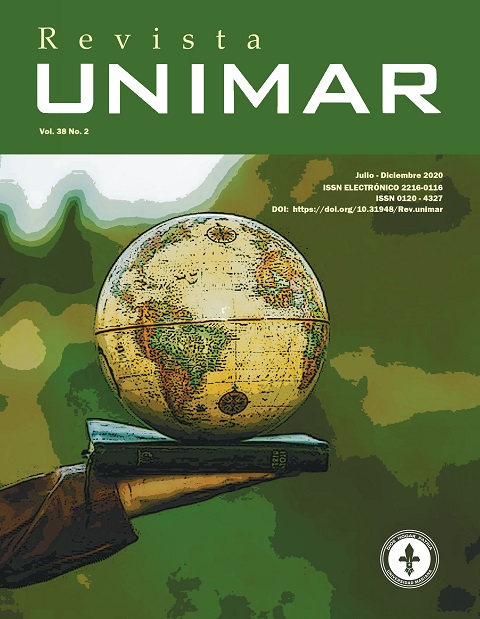Educar para la vida compasiva: Uno de los mayores desafíos para los educadores de hoy
DOI:
https://doi.org/10.31948/Rev.unimar/unimar38-2-art10Palabras clave:
compasión, comprensión, educación, Neurociencia, Psicología PositivaResumen
Casi todo los propósitos misionales y teleológicos de las instituciones educativas prescriben entre sus pretensiones, los anhelos de una sociedad más justa, solidaria y fraterna; pero si no se forma el carácter compasivo, difícilmente se conseguirá alcanzar tan noble ideal. Ello exige comenzar por incorporar la premisa de la compasión en el currículo y en el argot educativo, e implementar el andamiaje pedagógico-didáctico pertinente. En las siguientes líneas se esboza algunos argumentos para una educación centrada en la compasión, iniciativa que hunde sus raíces en un proyecto de aula denominado Generación Compasiva (fundado en 2015) y que, a partir de febrero de 2020, se plantea como investigación profesoral, la cual busca construir un corpus teórico que sirva de peana a esta perspectiva educativa. Se trata de un estudio eminentemente documental, enfocado en los aportes que han hecho la Neurociencia, la Psicología Positiva y Jesús de Nazaret con relación a este tema.
Biografía del autor/a
Luis Eduardo Pinchao-Benavides, Universidad Mariana
Licenciado en Filosofía y Teología de la Universidad Mariana; Magíster en Educación de la Pontificia Universidad Javeriana; Magíster en Pedagogía de la Universidad Mariana; docente investigador.
Referencias bibliográficas
Águeda, H. y Neto, L.M. (2008). Programa VIP: Hacia una psicología positiva aplicada. En C. Vázquez y G. Hervás (Coord.), Psicología Positiva Aplicada (pp. 311-338). Desclée de Brower.
Batson, C.D. (2009). These things called empathy: Eight related but distinct phenomena. In J. Decety & W. Ickes (Eds.), The social neuroscience of empathy (pp. 3–15). MIT Press. https://doi.org/10.7551/mitpress/9780262012973.003.0002
Brito, G. (2014). Cultivating healthy minds and open hearts: A mixed-method controlled study on the psychological and relational effects of compassion cultivation training in Chile https://www.semanticscholar.org/paper/Cultivating-healthy-minds-and-open-hearts%3A-A-study-Pons/dbafcf031f103df31154dbf01b5e59b12b05fed0
Delors, J. (1994). Los Cuatro Pilares de la Educación. En La educación encierra un tesoro. El Correo de la Unesco.
Escuelas bíblicas de Jerusalén. (2018). Biblia de Jerusalén (5.a ed. aprobada por la Comisión Permanente de la Conferencia Episcopal Española). Desclée de Brouwer.
Falletti, C., Mirabella, G., Paradiso, S., Pradier, J., Schranz, J., Czertok, H. y Mariti, L. (2010). Diálogos entre teatro y Neurociencia (Trad.) Juana Lor. Artezblai Ediciones.
Fava, G., & Ruini, C. (2003). Development and characteristics of a well-being enhancing psychotherapeutic strategy: Well-being therapy. Journal of Behavior Therapy and Experimental Psychiatry, 34, 45-63.
Feito, L. (2007). Las neuronas espejo nos ayudan a comprender las intenciones de los otros. Revista Electrónica Tendencias, 21. https://tendencias21.levante-emv.com/las-neuronas-espejo-nos-ayudan-a-comprender-las-intenciones-de-los-otros_a1498.html
Fogassi, L., Ferrari, P., Gesierich, B., Rozzi, S., Chersi, F. y Rizzolatti, G. (2005). Parietal lobe: from action organization to intention understanding. Sciencie,308(5722), 662-667. https://doi.org/10.1126/science.1106138
Fredrickson, B. (2003). The value of positive emotions. American scientist, 91(4), 330-335. https://doi.org/10.1511/2003.4.330
Gable, S.L., & Haidt, J. (2005). What (and why) is positive psychology? Review of General Psychology, 9, 103-110. https://doi.org/10.1037/1089-2680.9.2.103
Gallese, V., Rizzolatti, G., Fadiga, L., & Fogassi, L. (1996). Premotor cortex and the recognition of motor actions. Cognitive Brain Research, 3, 131-141. https://doi.org/10.1016/0926-6410(95)00038-0
Gallese, V., Migone, P., & Eagle, M. (2009). La simulación corporalizada: las neuronas espejo, las bases neurofisiológicas de la intersubjetividad y algunas implicaciones para el psicoanálisis. Revista Electrónica de Psicología, 3(3), 525-5556.
Goleman, D. (2015). La fuerza de la compasión. Kairos Editorial.
Góngora, V., & Castro, A. (2017). Assessment of the Mental Health Continuum in a Sample of Argentinean Adults. Psychology, 8(3), 303-318. https://doi.org/10.4236/psych.2017.83018
González, C. (20049. La Psicología Positiva: un cambio en nuestro enfoque patológico clásico. Liberabit Revista de Psicología, 10, 82-88.
Gyatso, T. (2004). Adiestrar la mente. Ediciones Dharma.
Hervás, G. (2009). Psicología Positiva: una introducción. Revista interuniversitaria de formación del profesorado, 66(23), 23-41.
Iacoboni, M. (2009). Las neuronas espejo. Empatía, neuropolítica, autismo, imitación, o de cómo entendemos a los otros (Trad. Isolda Rodríguez). Katz Editores. https://doi.org/10.2307/j.ctvm7bdfw
Iacoboni, M., Gordon, C., & Balasubramaniam, R. (2018). Multimodal Music Perception Engages Motor Prediction: A TMS Study. Frontiers Neurosciense, 5(18). https://doi.org/10.3389/fnins.2018.00736
Iacoboni, M., Bahr, M., Hou, J., Bikson, M., Gornbein, J., & Saver, J. (2019). Central Nervous System Electrical Stimulation for Neuroprotection in Acute Cerebral Ischemia: Meta-Analysis of Preclinical Studies. Stroke, 5(10), 892-2901. https://doi.org/10.1161/STROKEAHA.119.025364
Iacoboni, M., Christov, L., Reggente, N., Douglas, P., & Feusner, J. (2020). Predicting Empathy from Resting State Brain Connectivity: A Multivariate Approach. Frontiers in Integrative Neuroscience, 4(3). DOI: 10.3389/fnint.2020.00003.
Keltner, D., & Goetz, J. (2007). Compassion. In R.F. Baumeister & K.D. Vohs (Eds.),
Encyclopedia of social psychology (pp. 159–161). Sage Publications.
Keyes, C. (2013). Promoting and protecting positive mental health: Early and often throughout the lifespan. En Mental well-being (pp. 3-28). Springer. https://doi.org/10.1007/978-94-007-5195-8_1
Kolb, B., Mohamed, A., & Gibb, R. (2010). La búsqueda de los factores que subyacen a la plasticidad cerebral en los cerebros normal y en el dañado. Revista de Trastornos de la Comunicación, 10, 1016-1027. DOI: 10.1016/j.jcomdis.2011.040.007
Levi, P. (2012). Trilogía de Auschwitz. Editorial Océano.
Linley, A., Joseph, A., Harrington, S., & Wood, A. (2006). Positive psychology: Past, present and (possible) future. The Journal of Positive Psychology, 1(1), 3-16. https://doi.org/10.1080/17439760500372796
Linley, A. (2008). Average to A+: realising strengths in yourself and others. Coventry: CAPP Press.
Magdalena, G.J. (2008). El espíritu del educador. PPC Editorial.
Magendzo A. (1991). Los fantasmas de la educación. Editorial PIIE.
Mesurado, B. (2017). Psicología Positiva. En Vanney, C.E., Silva, I. y Franck, J. (Eds.). Diccionario Interdisciplinar Austral http://dia.austral.edu.ar/Psicolog%C3%ADa_positiva
Nussbaum, M. (2014). Las emociones políticas. ¿Por qué el amor es importante para la justicia? Editorial Paidós.
Park, N. y Paterson, C. (2009). Character strengths: Research and practice. Journal of college and character, 10(4). https://doi.org/10.2202/1940-1639.1042
Paterson, C. (2006). A Primer in Positive Psychology. Oxford University Press.
Paterson, C., & Seligman, M. (2004). Character strengths and virtues: A handbook and classification (Vol. 1). Oxford University Press.
Perugini, M., De la Iglesia, G., Solano, A., & Keyes, C. (2017). The Mental Health Continuum-Short Form (MHC-SF) in the Argentinean Context: Confirmatory Factor Analysis and Measurement Invariance. Europe’s Journal of Psychology, 13(1), 93-108. https://doi.org/10.5964/ejop.v13i1.1163
Ramachandran, V., Case, L., & Pineda, J. (2015). Common coding and dynamic interactions between observed, imagined, and experienced motor and somatosensory activity. Neuropsychologia, 79, 233-245. https://doi.org/10.1016/j.neuropsychologia.2015.04.005
Rizzolatti, G., Fadiga, L., Matelli, M. Bettinardi, V., Paulesu, E., Perani, D., & Fazio, F. (1996). Localization of grasp representations in humans by PET: 1. Observation versus execution. Experimental Brain Research, 238, 246-252. https://doi.org/10.1007/BF00227301
Rizzolatti, G., Umiltà, M., Kohler, E., Gallese, V., Fogassi, L., Fadiga., L., & Keysers, C. (2001). I know what you are doing. A neurophysiological study. Neuron, 32, 91-1001.
Rizzolatti, G. y Sinigaglia, C. (2006). Las neuronas espejo. Los mecanismos de la empatía emocional. Ediciones Paidós Ibérica.
Rizzolatti, G., Aziz, L., Wilson, S., & Iacoboni, M. (2006). Congruent embodied representations for visually presented actions and linguistic phrases describing actions. Current Biology, v. 16 (18), pp, 1818-1823. https://doi.org/10.1016/j.cub.2006.07.060
Rizzolatti, G., Lui, F., Buccino, G., Duzzi, D., Benuzzi, F., Crisi, G., Baraldi, P., Nichelli, P. & Porro, C. (2008). Neural substrates for observing and imagining non-object-directed actions. Social Neuroscience, (3), 268-269. https://doi.org/10.1080/17470910701458551
Rizzolatti, G., & Sinigaglia, C. (2010). The functional role of the parieto-frontal mirror circuit: interpretations and misinterpretations. Nature Reviews Neurosciense. 11, 264-274. https://doi.org/10.1038/nrn2805
Rizzolatti, G., Angelini, M., Fabbri, M., Lopomo, N., Gobbo, M., & Avanzini, P. (2018). Perspective-dependent reactivity of sensorimotor mu rhythm in alpha and beta ranges during action observation: an EEG study. Scientific Report, 8(1). https://doi.org/10.1038/s41598-018-30912-w
Rizzolatti, G., Di Cesare, G., Marchi, M., & Pinardi, C. (2019). Understanding the attitude of others by hearing action sounds: the role of the insula. Scietific Reports, 9(1). https://doi.org/10.1038/s41598-019-50609-y
Rizzolatti, G., Caruana, F., Avanzini, P., Pelliccia, V., Mariani, V., Zauli, F., Sartori, I, Del Vecchio, M., & Lo Russo, G. (2020). Mirroring other’s laughter. Cingulate, opercular and temporal contributions to laughter expression and observation. Cortex, 5(128), 35-48. https://doi.org/10.1016/j.cortex.2020.02.023
Ryff, C. (2013. Psychological well-being revisited: Advances in the science and practice of eudaimonia. Psychotherapy and psychosomatics, 83(1), 10-28. https://doi.org/10.1159/000353263
Seligman, M., & Csikszentmihalyi, M. (2000). Positive Psychology: An Introduction. American Psychologist, 55, 5-14. https://doi.org/10.1037/0003-066X.55.1.5
Seligman, M. (2005). La auténtica felicidad (Trad. M. Diago y A. Debrito). Ediciones B.S.A.
Sheldon, K.M., & Kasser, T. (2001). Goals, congruence and positive well-being. New empirical support for humanistic theories. Journal of humanistic psychology, 41, 30-50. https://doi.org/10.1177/0022167801411004
Singer, T., & Lamm, C. (2009). The social neuroscience of empathy. The Year in Cognitive Neuroscience 2009. Annals of the New York Academy of Sciences, 1156, https://doi.org/10.1111/j.1749-6632.2009.04418.x81-96.
Umiltà, M., Kohler, E., Gallese, V., Fogassi, L., Fadiga, L., Keysers, C. y Rizzolatti, G. (2001). I know what you are doing. A neurophysiological study. Neuron, 31(1), 155-165.
Umiltà, M., Escola, L., Intskirveli, I., Grammont, F., Rochat, M., Caruana, F., Jezzini, A., Gallese, V. & Rizzolatti, G. (2008). When pliers become fingers in the monkey motor system. National Academy of Sciences, 105(6), 2209-2213. https://doi.org/10.1016/S0896-6273(01)00337-3
Umiltà, M., Heimann, K., & Gallese, V. (2013). How the motor-cortex distinguishes among letters, unknown symbols and scribbles. A high density EEG study. Neuropsychologia, 51, 2833-2840. https://doi.org/10.1073/pnas.0705985105
Umiltà, M., Heimann, K., Guerra, M., & Gallese V. (2014). Moving mirrors: A high density EEG study investigating the effects of camera movements on motor cortex activation during action observation. Journal of Cognitive Neuroscience. https://doi.org/10.1016/j.neuropsychologia.2013.07.014
Umiltà, M., Calbi, M., Angelini, M., & Gallese, V. (2017). Embodied Body Language: an electrical neuroimaging study with emotional faces and bodies. Scientific Reports, 7(1). https://doi.org/10.1038/s41598-017-07262-0
Umiltà, M., Calbi, M., Aldouby, H., Gersht, O., Langiulli, N., & Gallese, V. (2019). Haptic Aesthetics and Bodily Properties of Ori Gersht’s Digital Art: A Behavioral and Eye-Tracking Study. Frontiers in Psychology, 10. https://doi.org/10.3389/fpsyg.2019.02520
Umiltà, M., Ardizzi, M., Calbi, M., Tavaglione, S., & Gallese, V. (2020). Audience spontaneous entrainment during the collective enjoyment of live performances: physiological and behavioral measurements. Scientific Reports, 10(1). https://doi.org/10.1038/s41598-020-60832-7
Vázquez, C., Hervás, G. y Ho, M. (2006). Intervenciones clínicas basadas en la psicología positiva: Fundamentos y aplicaciones. Psicología Conductual, 14, 401-432.
Vázquez, C., Castilla, C. y Hervás, G. (2008). Reacciones frente al trauma: vulnerabilidad, resistencia y crecimiento. En E. Fernández-Abascal (Ed.), Las emociones positivas (pp. 375-392). Editorial Pirámide.
Worthington, E. (2006). Forgiveness and reconciliation: Theory and application. Brunner-Routledge.
Worthington, E., Oyen, C., Pietrini, P., & Miller, A. (2007). Forgiveness, Health, and Well-Being: A Review of Evidence for Emotional Versus Decisional Forgiveness, Dispositional Forgivingness, and Reduced Unforgiveness. Journal of Behavioral Medicine, 30, 291-302. https://doi.org/10.1007/s10865-007-9105-8
Cómo citar
Descargas
Publicado
Número
Sección
Licencia

Esta obra está bajo una licencia internacional Creative Commons Atribución 4.0.
Los autores que publiquen en esta revista aceptan las siguientes condiciones:
1. Los autores conservan los derechos de autor y ceden a la revista el derecho de la primera publicación, con el trabajo registrado con la licencia de atribución de Creative Commons, que permite a terceros utilizar lo publicado siempre que mencionen la autoría del trabajo y a la primera publicación en esta revista.
2. Los autores pueden realizar otros acuerdos contractuales independientes y adicionales para la distribución no exclusiva de la versión del artículo publicado en esta revista (p. ej., incluirlo en un repositorio institucional o publicarlo en un libro) siempre que indiquen claramente que el trabajo se publicó por primera vez en esta revista.
3. Se permite y recomienda a los autores publicar su trabajo en Internet (por ejemplo en páginas institucionales o personales) antes y durante el proceso de revisión y publicación, ya que puede conducir a intercambios productivos y a una mayor y más rápida difusión del trabajo publicado (veaThe Effect of Open Access).
| Estadísticas de artículo | |
|---|---|
| Vistas de resúmenes | |
| Vistas de PDF | |
| Descargas de PDF | |
| Vistas de HTML | |
| Otras vistas | |








